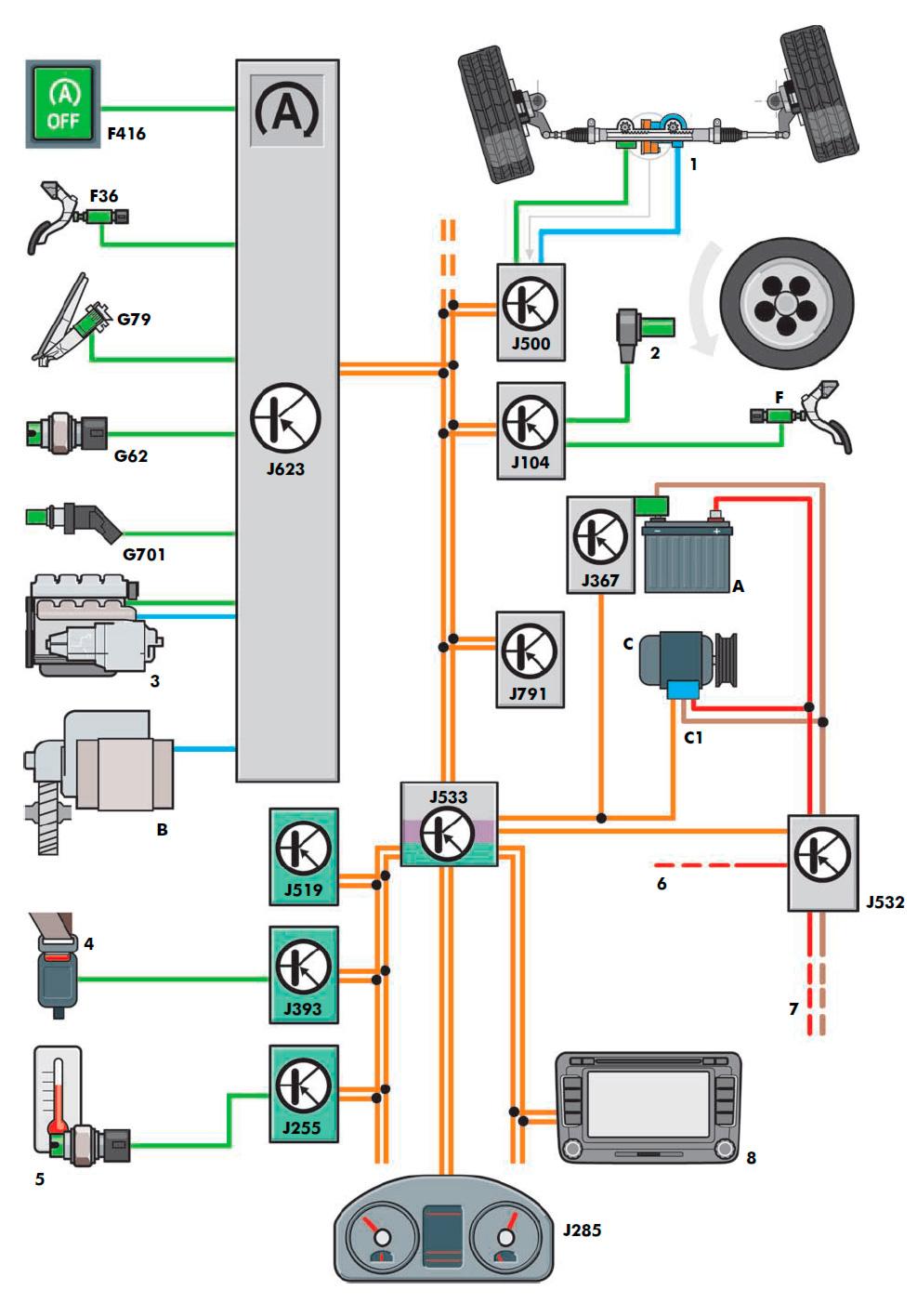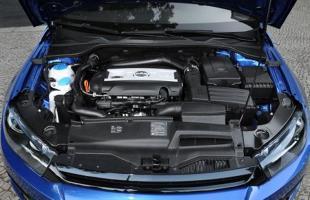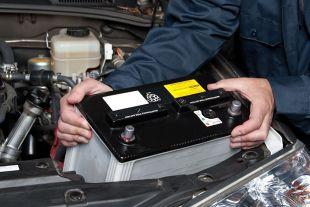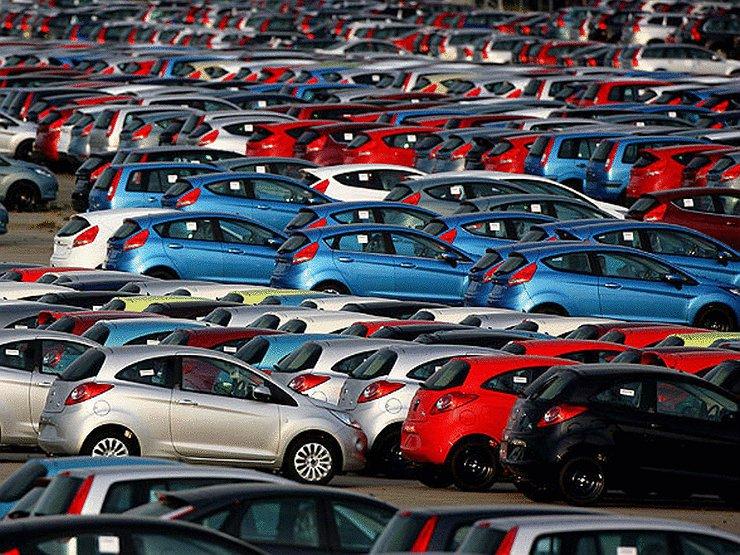
Start-Stop systems. It works?
 One of the ways to reduce fuel consumption, known for many years, is to turn off the engine during even a short stop of the car. In modern cars, Start-Stop systems are responsible for this task.
One of the ways to reduce fuel consumption, known for many years, is to turn off the engine during even a short stop of the car. In modern cars, Start-Stop systems are responsible for this task.
 In a driving test carried out in Germany in the 55s on an Audi LS with a 0,35 kW engine, it was found that the fuel consumption at idle is 1,87 cm5. XNUMX./s, and at the start of XNUMX, see XNUMX. This data showed that turning off the engine with a stop for more than XNUMX seconds saves fuel.
In a driving test carried out in Germany in the 55s on an Audi LS with a 0,35 kW engine, it was found that the fuel consumption at idle is 1,87 cm5. XNUMX./s, and at the start of XNUMX, see XNUMX. This data showed that turning off the engine with a stop for more than XNUMX seconds saves fuel.
At about the same time, similar tests were carried out by other car manufacturers. The ability to reduce fuel consumption by stopping the engine even at a very short stop and restarting it has led to the development of control devices that perform these actions automatically. The first was probably Toyota, which in the seventies used an electronic device in the Crown model that turned off the engine at a stop for more than 1,5 seconds. Tests in Tokyo traffic jams showed a 10% reduction in fuel consumption. A similarly functioning system was tested in a Fiat Regata and a 1st Formel E Volkswagen Polo. A device in the latter car allowed the driver to stop the engine, or just automatically, depending on speed, engine temperature, and gear lever position. The engine was restarted with the starter turned on when the driver pressed the accelerator pedal with the clutch pedal depressed and the 2nd or 5th gear was engaged. When the vehicle speed dropped below XNUMX km/h, the system turned off the engine, closing the idle channel. If the engine was cold, the temperature sensor blocked the engine shutdown to reduce wear on the starter, because a warm engine takes much less time to start than a cold one. In addition, the control system, to reduce the load on the battery, turned off the heated rear window when the car was parked.
Road tests have shown a reduction in fuel consumption of up to 10% in adverse driving conditions. Carbon monoxide emissions also decreased by 10%. Slightly more than 2 percent. on the other hand, the content of nitrogen oxides and almost 5 hydrocarbons in the exhaust gases has increased. Interestingly, there was no negative effect of the system on the durability of the starter.
Modern start-stop systems
 Modern start-stop systems automatically shut off the engine when parked (under certain conditions) and restart it as soon as the driver depresses the clutch pedal or releases the brake pedal in an automatic transmission vehicle. This reduces fuel consumption and carbon emissions, but only in urban traffic. Using the Start-Stop system requires certain vehicle components, such as the starter or battery, to last longer and protect others from the effects of frequent engine shutdowns.
Modern start-stop systems automatically shut off the engine when parked (under certain conditions) and restart it as soon as the driver depresses the clutch pedal or releases the brake pedal in an automatic transmission vehicle. This reduces fuel consumption and carbon emissions, but only in urban traffic. Using the Start-Stop system requires certain vehicle components, such as the starter or battery, to last longer and protect others from the effects of frequent engine shutdowns.
Start-Stop systems are equipped with more or less sophisticated energy management systems. Their main tasks include checking the state of charge of the batteries, configuring the receivers on the data bus, reducing power consumption and obtaining the optimal charging voltage at the moment. All this in order to avoid too deep discharge of the battery and to ensure that the engine can be started at any time. By constantly evaluating the condition of the battery, the system controller monitors its temperature, voltage, current and operating time. These parameters determine the instantaneous starting power and the current state of charge. If the system detects a low battery level, it reduces the number of enabled receivers according to the programmed shutdown order.
Start-Stop systems can be optionally equipped with braking energy recovery.
Vehicles with Start Stop systems use EFB or AGM batteries. Batteries of the EFB type, unlike the classic ones, have positive plates coated with a polyester coating, which increases the resistance of the active mass of the plates to frequent discharges and high current charges. AGM batteries, on the other hand, have glass fiber between the plates, which completely absorbs the electrolyte. There are practically no losses from it. A slightly higher voltage can be obtained at the terminals of this type of battery. They are also more resistant to the so-called deep discharge.
Does it harm the engine?
Several decades ago, it was believed that each engine start increases its mileage by a few hundred kilometers. If this were the case, then the Start-Stop system, which works in a car that only drives in city traffic, would have to finish the engine very quickly. Keeping on and off is probably not what engines like best. However, technical progress must be taken into account, for example in the field of lubricants. In addition, the Start-Stop system requires effective protection of various systems, primarily the engine, from the consequences of frequent shutdowns. This applies, among other things, to ensure additional forced lubrication of the turbocharger
Starter in Start-Stop system
In most start-stop systems in use, the engine is started using a traditional starter. However, due to the significantly increased number of operations, it has increased durability. The starter is more powerful and equipped with more wear-resistant brushes. The clutch mechanism has a redesigned one-way clutch and the gear has a corrected tooth shape. This results in quieter starter operation, which is important for driving comfort during frequent engine starts.
Reversible generator
 Such a device called StARS (Starter Alternator Reversible System) was developed by Valeo for Start-Stop systems. The system is based on a reversible electric machine, which combines the functions of a starter and an alternator. Instead of a classic generator, you can easily install a reversible generator.
Such a device called StARS (Starter Alternator Reversible System) was developed by Valeo for Start-Stop systems. The system is based on a reversible electric machine, which combines the functions of a starter and an alternator. Instead of a classic generator, you can easily install a reversible generator.
The device provides a very smooth start. Compared to a conventional starter, there is no connection process here. When starting, the stator winding of the reversible alternator, which at this time becomes an electric motor, must be supplied with alternating voltage, and the rotor winding with direct voltage. Getting AC voltage from the onboard battery requires the use of a so-called inverter. In addition, the stator windings should not be supplied with alternating voltage through a voltage stabilizer and diode bridges. The voltage regulator and diode bridges must be disconnected from the stator windings for this time. At the moment of start-up, the reversible generator becomes an electric motor with a power of 2 - 2,5 kW, developing a torque of 40 Nm. This allows you to start the engine within 350-400 ms.
As soon as the engine starts, the AC voltage from the inverter stops flowing, the reversible generator becomes an alternator again with diodes connected to the stator windings and a voltage regulator to supply DC voltage to the vehicle's electrical system.
In some solutions, in addition to the reversible generator, the engine is also equipped with a traditional starter, which is used for the first start after a long period of inactivity.
Energy accumulator
In some solutions of the Start-Stop system, in addition to a typical battery, there is also a so-called. energy accumulator. Its task is to accumulate electricity to facilitate the first engine start and re-start in the "Start-Stop" mode. It consists of two capacitors connected in series with a capacity of several hundred farads. At the moment of discharge, it is capable of supporting a starting system with a current of several hundred amperes.
terms of Use
The operation of the Start-Stop system is only possible under a number of different conditions. First of all, there must be enough energy in the battery to restart the engine. In addition, incl. the vehicle speed from the first start must exceed a certain value (for example, 10 km/h). The time between two successive stops of the car is greater than the minimum set by the program. Fuel, alternator and battery temperatures are within the specified range. The number of stops did not exceed the limit in the last minute of driving. The engine is at optimum operating temperature.
These are just some of the requirements that must be met for the system to work.
